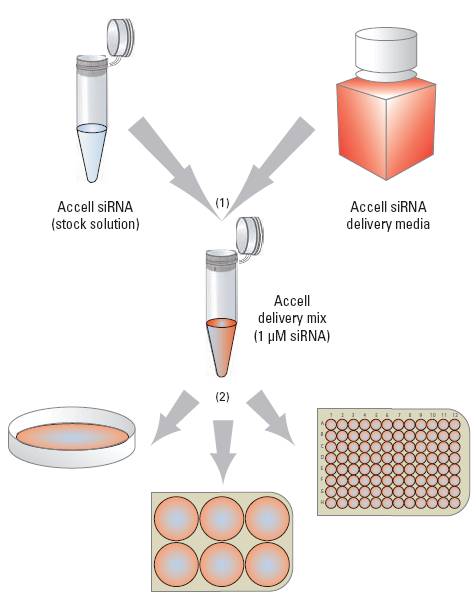The only self-delivering siRNA for difficult-to-transfect cells carries a functional guarantee!
Accell siRNA provides a revolutionary solution for RNAi in cells that are resistant to conventional transfection methods, or cannot tolerate viral transduction or electroporation. Hundreds of peer-reviewed publications have demonstrated successful target gene silencing in primary neurons, β-islet cells, macrophages, T-cells, and more, including in vivo studies.
The main determiner in successful delivery (and subsequent silencing) by Accell siRNA is the cells’ tolerance to serum-free conditions, since serum interferes with Accell siRNA’s passive delivery. If the following three steps are carried out, we guarantee at least 75% silencing (measured by qPCR) by the Accell SMARTpool and three of the Set of 4 individual siRNAs targeting your gene of interest.

The Accell siRNA application protocol simplifies targeted gene knockdown
Step 1: Culture your cells in a serum-free medium for 72 hours
Serum-free medium can be:
The cells’ usual growth medium with no serum added
or
Any other highly supplemented, yet serum-free medium, such as Accell Delivery Media (B-005000-100, -500).
Evaluate the cells’ overall appearance and viability in comparison to cells grown for 72 hours in their normal growth medium. If the serum-free cells do not have significant differences in observable characteristics (viability, growth rate, morphology) to those in growth medium, proceed to Step 2. If not, contact Scientific Support for assistance.
Step 2: Assess positive and negative Accell siRNA controls
Culture cells in serum-free medium (as in Step 1) with positive and negative (non-targeting) controls at 1 µM final siRNA concentration, along with untreated cells. Recommended controls (Table 1) are available individually or as Accell Control Kits (red: Cat # K-005000-R1-01, -02, -03 or green: Cat # K-005000-G1-01, -02, -03).
The full Accell Delivery Protocol can be found here.
|
Control type |
Accell siRNA control |
Catalog number |
|---|---|---|
|
Positive control(option one) |
D-001930-01- (human) D-001930-02- (mouse) D-001930-03- (rat) |
|
|
Positive control (option two) |
D-001920-01- (human) D-001920-02- (mouse) D-001920-03- (rat) |
|
|
Negative control (option one) |
D-001910-01-xx |
|
|
Negative control (option two) |
Accell Green (FAM) or Red (Cy3) Non-targeting siRNA |
D-001950-01- (green) D-001960-01- (red) |
|
Untreated cells |
Untreated cells |
N/A |
At 72 hours, carry out the following assessments:
Confirm the cells’ phenotype and viability as in Step 1. The cells treated with Accell Non-targeting siRNA control should be similar to untreated cells.
If using a Green or Red Non-targeting siRNA, look for intracellular fluorescence as a qualitative estimate of delivery efficiency.
Measure the mRNA level (qPCR) of Cyclophilin B and/or GAPDH and compare levels across all samples. You should see 75-95% silencing of the positive control siRNA compared to Non-targeting siRNA. If so, proceed to Step 3. If not, contact Scientific Support for assistance.
Step 3: Repeat step 2 but include Accell SMARTpool or the Set of 4 siRNAs targeting your gene(s) of interest
Perform all the same comparisons as in Step 2, but include mRNA level quantitation for your gene(s) of interest. When compared to Non-targeting siRNA, you should see at least a 75% reduction. If you do not, contact Scientific Support.
Product replacement guarantee
If all three of the steps above are carried out as described, you are guaranteed at least 75% target gene silencing by either the SMARTpool or three of the Set of 4 individual siRNAs. If, after contacting Scientific Support and carrying out recommended troubleshooting, your target gene is not silenced by at least 75%, a one-time replacement of the affected Accell SMARTpool or Set of 4 siRNA reagents will be provided.
Learn more with the resources below
-
Accell siRNA delivery - Protocol
Delivery of Accell siRNA to adherent or suspension cells -
Accell siRNA - Achieving long-term gene silencing - Application note
Repeated dosing resulted in knockdown up to 30 days -
siRNA resuspension - Protocol
This protocol is written for siRNA, but may also be applied to microRNA mimic and hairpin inhibitor resuspension. -
Gene silencing workflow with Accell siRNA - Application note
An overview of good experimental planning and design using Accell siRNA
